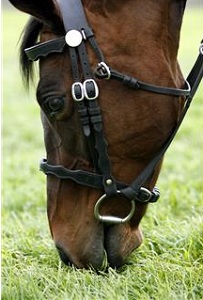 As you may know, eye movement desensitization and reprocessing (EMDR) is a research- and evidence-based therapy created by Francine Shapiro, Ph.D., over 20 years ago. An integrative model, EMDR is comprehensive, including aspects of multiple psychotherapeutic approaches. With this in mind, equine experiential activities, such as those found in equine-assisted psychotherapy (EAP), support and help to facilitate EMDR’s eight-phased model, while also maintaining fidelity to standard protocol.
As you may know, eye movement desensitization and reprocessing (EMDR) is a research- and evidence-based therapy created by Francine Shapiro, Ph.D., over 20 years ago. An integrative model, EMDR is comprehensive, including aspects of multiple psychotherapeutic approaches. With this in mind, equine experiential activities, such as those found in equine-assisted psychotherapy (EAP), support and help to facilitate EMDR’s eight-phased model, while also maintaining fidelity to standard protocol.
The EquiLateral™ protocol is brought with a deep respect and understanding of EMDR but also the power of equine-assisted therapy. I am constantly reminded that EMDR and equine-assisted therapy both have the ability to support and often deepen a client’s ability to access where those traumas are stored. In my 10 years of experience as an EMDR therapist, I am still constantly amazed and inspired by the depth of healing that can be reached through EMDR, let alone through horses, who are often our most powerful and forgiving teachers.
Current research emphasizes the importance of maintaining fidelity to EMDR’s eight-phased approach. Nevertheless, in doing so, EMDR “may be implemented in more than one way as long as the broad goals of each phase are achieved” (www.emdria.org).
EquiLateral™ is the first equine-assisted EMDR protocol. We are still doing EMDR but are incorporating equine-assisted experiences within the eight-phased, three-prong, standard EMDR protocol. For more information on this approach to healing trauma, please visit my website: www.dragonflyinternationaltherapy.com
Horses, Comfort, and PTSD
Horses are prey animals. What this means is that they are highly in tune with their environment, readily noticing changes in the world around them and being able to respond to what they notice and actively seek what horseman Buck Brannaman describes as their wanting to return to “peace.” When in this energetic state, their nervous systems are settled and calm. They can readily focus on just being in the world, in the moment, which for them means grazing, moving 20+ miles a day, and relating with herd members. In contrast, when sensing danger, their peace is threatened, and their nervous system becomes activated enabling them to react, primarily through flight, although sometimes through fight or freeze, for self-preservation.
If you are a trauma survivor or know someone who struggles with posttraumatic stress, perhaps you can relate. Our bodies have the capacity to do as horses do, react, respond, then calm down and return to “peace.” But, we humans often learned to “stuff,” “repress,” “deny” what happened when all the body really wants to do is release and move through those feelings and body sensations. Doing so actually helps the trauma memory settle in, to release the “charge” that the body stores about what happened. By nature, horses, like all animals, know how to do this.
But, when trauma is still locked in the body and blocked, our nervous systems don’t return to a baseline of calm and peace. Instead, the fight, flight, or freeze that was experienced at the time of the event continues to remain activated, leading one to feel on alert, hypersensitive, anxious, easily agitated, or constantly “on,” making it challenging and often nearly impossible to relax.
That said, horses know how to relax. But, they also instinctively know to be alert and flee when threatened. They are preyed upon in the wild and are really in tune to danger, of any kind, including that which threatens their physical and even emotional safety, and that sense of comfort and peace that is their baseline state of being. And if you are a trauma survivor, all you want is peace and comfort as well. And this is just the beginning of why the horse and the trauma survivor may just “get” each other.
In light of the powerful connection between horses and trauma survivors, I am consistently shown the power of horses to help heal humans, especially through the integration of EMDR and equine-assisted therapy via this protocol.
Keep an eye out for the Part 2 of this post coming soon!
Related articles:
EMDR: Symptoms and Phases
Common Therapy Approaches to Help You Heal from Trauma
How Trauma Impacts My Sense of “Me-Ness” – Part II

The preceding article was solely written by the author named above. Any views and opinions expressed are not necessarily shared by GoodTherapy.org. Questions or concerns about the preceding article can be directed to the author or posted as a comment below.



